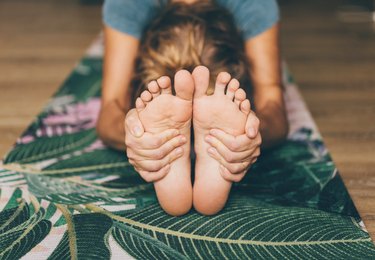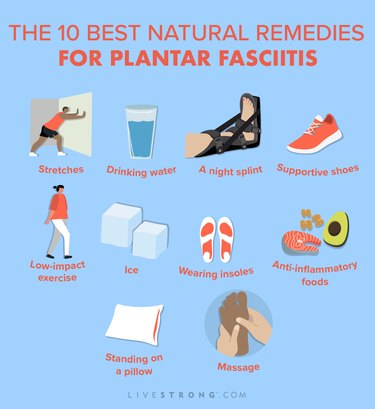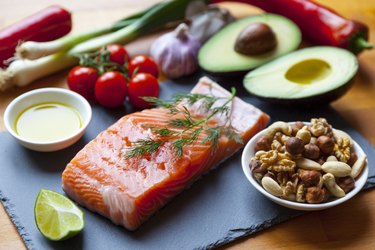
If you're among the 2 million people treated for plantar fasciitis each year, according to the American Academy of Orthopaedic Surgeons, you know the painful inflammation of the tissue on the bottom of your foot can sometimes feel unbearable.
In a March 2018 Journal of Pain study, 70 percent of people with plantar fasciitis reported having moderate to severe pain, with more than half reporting that it interfered with their normal work activities.
Video of the Day
Video of the Day
We're going to be brutally honest with you: There is no quick fix for plantar fasciitis — you can't eradicate it in minutes or even weeks.
"Plantar fasciitis is a very difficult condition to resolve," says podiatrist Mark Mendeszoon, DPM, director of the Advanced Foot and Ankle Fellowship with University Hospitals Richmond Medical Center, clinical professor at Ohio University Heritage Medical School, professor at Kent State University School of Podiatric Medicine and spokesperson for the American Podiatric Medical Association. "It is usually chronic and can last for a long time: several months to several years. There are no fast ways to cure plantar fasciitis and no treatments that are 100 percent effective."
But don't despair — despite plantar fasciitis's staying power, plenty of people find at least some degree of relief from natural remedies like these.

1. Try Stretching Daily
First, a quick recap on what causes plantar fasciitis: "Plantar fascia is a band of tissue that stretches from the heel to the ball of the foot," Dr. Mendeszoon says. "It is thick, brawny and inelastic in order to help support the foot — after all, the average person puts several million pounds of weight on their feet every day."
But overuse (such as excessive walking, running or jumping) or a mechanical issue with your tootsies — including flat feet, high arches or a tight Achilles tendon — can damage your plantar fascia. "These conditions put a great deal of stress and strain on the plantar fascia," Dr. Mendeszoon says. "As a result, the tissue will likely start to tear and rip off your heel bone, causing microscopic bleeding, pain and inflammation."
Because we're talking about stretching here, let's take a closer look at how a tight Achilles tendon aggravates plantar fasciitis: "The Achilles tendon is the longest, strongest tendon in the body, and it should be able to dorsal flex past 90 degrees — meaning, if you stick your leg straight out and bring your toes towards your nose, your foot should be bent more than the letter L," Dr. Mendeszoon says. "But many Americans have a tight Achilles tendon — as a result, when they walk or run all the pressure is concentrated on the front of their foot."
With that in mind, enhancing your flexibility can help. A 2018 statement from the American College of Foot and Ankle Surgeons (ACFAS) confirmed that stretching is "extremely important" in the treatment of plantar fasciitis. People who stretch their plantar fascia and Achilles tendon experience pain relief, greater stability and improved function.
How to Do It
Dr. Mendeszoon recommends doing the following stretches twice a day. Hold each for 20 to 30 seconds per side and do 8 to 10 reps. Be sure not to bounce, as this could further tear the tissue.
- Heel drops: Stand on a step with your heel hanging off the edge. Let your heel drop down below your toes.
- Wall stretch: Stand facing a wall, about an arm's length away. Press your palms flat against the wall, shoulder-width apart. Slide one leg back, keeping your heel on the ground and your knee locked straight. Bend your front knee slightly and push your hips forward until you feel a lower calf stretch.
- Towel stretch: Sit on the ground with your legs extended in front of you. Loop a towel or exercise band around the ball of one foot. Hold the ends of the towel in your hands, and pull your toes back toward you to feel a stretch.
2. Drink Water

H2O to the rescue! A 2017 study in the European Journal of Sports & Exercise Science found that people who are dehydrated had decreased flexibility, reduced range of motion and greater stiffness in the muscles of their legs — all of which can worsen plantar fasciitis.
How to Do It
Ideally, you'd guzzle between a half gallon to a gallon of water daily. If you're not there yet, increase your fluid intake gradually.
"The rule of thumb is that your urine should be clear and odorless," Dr. Mendeszoon says. "If it looks like apple juice or smells pungent, you're in trouble."
3. Wear a Night Splint
A night splint is a device you strap onto your foot to passively stretch your Achilles tendon while you sleep.
The ACFAS statement revealed that folks who wear night splints had a 30 to 50 percent reduction in pain after 12 weeks, with some people seeing improvements after just four weeks. They also had a significantly shorter recovery time.
Buy It
Plantar Fasciitis Posterior Night Splint ($24.99, Amazon)
How to Do It
Jumping feet first into a night splint can be uncomfortable. So build up your tolerance gradually.
"Wear it for just 20 minutes the first day, adding five minutes a day until eventually you can sleep with it on for the whole night," Dr. Mendeszoon says.
4. Get Supportive Shoes

Avoid going barefoot or wearing super-flat shoes like flip flops. "It puts more stress on your heels, which makes plantar fasciitis worse," Dr. Mendeszoon says.
A better bet is sneakers. The cushioning will ease heel discomfort and the structure helps counteract harmful anatomical issues like flat feet and high arches.
Related Reading
How to Do It
Because everyone's feet are so different, consult a pro about which shoes are right for you. "Head to your local running store, where they will watch you move and professionally fit you in the right sneaker," Dr. Mendeszoon says.
A few more tips to keep in mind: Toss old kicks. "Shoes are good for about 500 miles," Dr. Mendeszoon says. After that, the cushioning is worn out, so they won't support your feet effectively and will put greater pressure on your soles.
It's also smart to rotate your shoes. "If you wear the same pair every day, the shoe will break down faster because your weight is constantly pushing down on the material," Dr. Mendeszoon says.
Finally, don't ask your shoes to do double duty. "Separate your athletic shoes from your work and lifestyle shoes," Dr. Mendeszoon says. "If you spend all day in a pair of shoes and then work out in them, they may not provide the support and cushioning you need."
5. Do Low-Impact Exercise
When your feet are aching, you're probably tempted to put them up. But it turns out, staying active (in the right way) reduces discomfort. "Movement helps keep the tissue loose," Dr. Mendeszoon says.
You may have noticed that your heel hurts more in the morning or after a period of inactivity — like a long car ride or sitting in front of your computer. That's because the plantar fascia has become stiff and tight. "This pain typically resolves once you warm up the body," Dr. Mendeszoon says.
What's more, weight gain is negatively associated with plantar fasciitis. A July 2017 study in the Journal of Foot and Ankle Research found that increased body weight led to greater heel pressure and foot pain. So keeping up with exercise is also a good idea on that front.
That said, high-impact activities where both feet are off the ground aggravate plantar fasciitis by putting added pressure on your feet. "For instance, running puts eight times your body weight on your feet compared to walking," Dr. Mendeszoon says. Other high-intensity sports that belong in the what-not-to-do category: Tennis, basketball and racquetball.
An April 2016 Singapore Medical Journal study recommended non-weight-bearing activities like swimming, cycling and rowing for plantar fasciitis.
How to Do It
Dr. Mendeszoon urges folks to walk a minimum of 5,000 steps a day, working toward 10,000. You can also try this treadmill routine, which he has found to be extremely helpful over time:
- Walk for five minutes on a low incline of 1 to 2 degrees.
- Raise the incline to 10 degrees and walk at a brisk pace for 20 minutes.
- Cool down by lowering the incline to 1 to 2 degrees again and walking for five more minutes.
"It's a good cardiovascular workout because you are walking aggressively, yet because you always have one foot on the ground, you are not putting extra weight and impact on your feet," Dr. Mendeszoon says. "In addition, the incline stretches out your Achilles tendon and plantar fascia."
6. Apply Ice

For folks with plantar fasciitis, it's good to get cold feet! "Ice reduces inflammation and numbs the pain," Dr. Mendeszoon says.
A November 2013 study in the Korean Academy of Physical Therapy Rehabilitation Sciences found that applying a cold wrap to the feet for 20 minutes at bedtime reduced planter fascia thickness by 13 percent, decreased pain by 44 percent and increased by 86 percent the amount of force that could be applied to the feet without pain.
How to Do It
Dr. Mendeszoon recommends applying ice twice a day for 10 minutes. You can use a cold wrap or freeze paper cups filled with water and slide them over the soles of your feet. (Tear back the paper as needed.)
Or try this method suggested in the Singapore Medical Journal study: Freeze a small (6- to 8-ounce) can. At the end of the day, roll the can back and forth under the sole of your foot using medium pressure.
7. Add Insoles
Put your best foot forward with a pair of shoe inserts. A December 2015 study in the Journal of Oklahoma State Medical Association found that orthotics significantly improved plantar fasciitis pain and restored function. "Insoles help distribute weight properly across the foot," Dr. Mendeszoon says.
How to Do It
Prescription orthotics are expensive, so before footing the bill, try over-the-counter insoles. "They can be very helpful," Dr. Mendeszoon says. "If you don't notice an improvement, then you may need to be fitted by a podiatrist for a custom pair."
8. Eat an Anti-Inflammatory Diet

Because plantar fasciitis is an inflammatory condition, decreasing overall inflammation might be helpful.
"Sticking to a Mediterranean diet and eating anti-inflammatory foods such as garlic, turmeric and olive oil could help with plantar fasciitis," Dr. Mendeszoon says.
How to Do It
According to the Academy of Nutrition and Dietetics, you might reduce systemic inflammation by upping your intake of fruits, vegetables and healthy fats such as monounsaturated fats and omega-3 fatty acids.
Meanwhile, avoid inflammation triggers, including processed foods and those containing high levels of saturated fats and trans fat. These foods could be bad for plantar fasciitis.
9. Try Standing on a Pillow
A lot of people find that their heel pain is worse in the morning, when their muscles are stiff. And stepping onto your hard bedroom floor in bare feet makes them even more ouchy. According to Dr. Mendeszoon, pressing your feet into a soft pillow first thing can help.
How to Do It
As soon as you wake up, throw an extra pillow on the floor. Stand on it for 60 to 90 seconds and rock back-and-forth. Then, instead of stepping barefoot onto the floor, slip your feet immediately into sandals or slippers. "Typically, planter fasciitis will resolve and improve temporarily as the body warms up," Dr. Mendeszoon says.
10. Get a Massage

Here's proof that you deserve a foot rub! A September 2019 study in the Journal of Interdisciplinary Health Sciences found that five minutes of deep tissue massage helped improve plantar fasciitis pain, flexibility and range of motion.
Meanwhile, prior research has shown that a calf rubdown is helpful, too. In an April 2014 study in Manual Therapies, deep calf massage combined with stretching resulted in short-term relief of heel pain.
How to Do It
Here's the technique used in the Journal of Interdisciplinary Health Sciences study:
- Flex your foot so your toes are pulled back.
- Locate the most painful area of the heel. Using one or two fingers, massage back and forth across this area in a 1-inch radius, using firm pressure.
- Make sure the friction is deep enough that you are taking the skin with you, rather than sliding your fingers across the skin.
To target your calf muscles:
- Cross one ankle on top of the opposite knee so your calf is facing you.
- Push your thumbs into sore areas along the center and sides of your calves and firmly palpate for 10 minutes.
What About Herbs?
Put on a pot of curry! A May 2016 review in Advances in Pharmacological Sciences evaluated the power of herbs — including turmeric, ginger, rosemary and sage — to reduce systemic inflammation. The review found the most reliable clinical data for turmeric, suggesting that it can help with inflammatory conditions.
"However, there's no scientific evidence any natural anti-inflammatory product will completely alleviate planter fasciitis," Dr. Mendeszoon says.
If you want to give herbs a shot, whip up a turmeric latte: On the stovetop, heat 1 cup of your milk of choice (cow, almond, coconut, etc.). Mix in ½ teaspoon each of turmeric, cinnamon, cardamom, ginger and honey, plus a few grinds of black pepper. Sip and enjoy.
What About an Herbal Foot Bath?
Unfortunately there's no science to support using herbal foot soaks for plantar fasciitis.
But there's also no harm, so if it feels soothing to dip your tootsies into a tub of warm water, go for it.
What About Juicing?
Fake news alert: You may have read that drinking certain types of juice — including tart cherry, pineapple, grape, veggie or lemon — can cure plantar fasciitis by reducing inflammation. Negative.
"There are no statistical studies to show this," Dr. Mendeszoon says.
What About Apple Cider Vinegar?
You're better off pouring ACV on your salad instead of on your feet. This popular cure-all won't do a thing to alleviate plantar fasciitis.
- European Journal of Sports & Exercise Science : "Dehydration Reduces Posterior Leg and Trunk Flexibility and Increases Stiffness in Male Collegiate Age Runners"
- Journal of Foot and Ankle Research: "Increase in body weight over a two-year period is associated with an increase in midfoot pressure and foot pain"
- Korean Academy of Physical Therapy Rehabilitation Sciences : "Evidence-based use of cold for plantar fasciitis"
- Singapore Medical Journal: "Management of plantar fasciitis in the outpatient setting"
- Journal of Oklahoma State Medical Association : "Orthotics Compared to Conventional Therapy and Other Non-Surgical Treatments for Plantar Fasciitis"
- Academy of Nutrition and Dietetics: "Can Diet Help with Inflammation?"
- Advances in Pharmacological Sciences : "Review of Anti-Inflammatory Herbal Medicines"
- Journal of Interdisciplinary Health Sciences: "Manual therapy interventions in the treatment of plantar fasciitis: A comparison of three approaches"
- Manual Therapies: "Deep massage to posterior calf muscles in combination with neural mobilization exercises as a treatment for heel pain: a pilot randomized clinical trial"
- AAOS: "Plantar Fasciitis and Bone Spurs"
- Journal of Pain: "Prevalence and Pharmaceutical Treatment of Plantar Fasciitis in United States Adults"
- American College of Foot and Ankle Surgeons: "American College of Foot and Ankle Surgeons Clinical Consensus Statement: Diagnosis and Treatment of Adult Acquired Infracalcaneal Heel Pain"
Is this an emergency? If you are experiencing serious medical symptoms, please see the National Library of Medicine’s list of signs you need emergency medical attention or call 911.